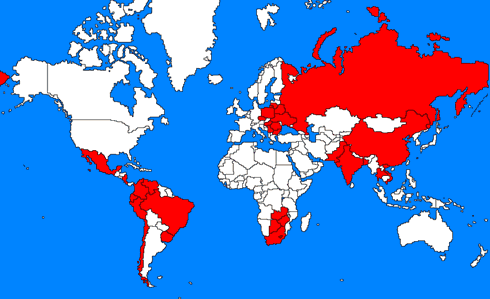Global Collaborations
Activities: NIOSH Funded Research Grants
NIOSH sponsors research and training through its extramural programs, which complement the Institute's intramural programs. More information is available from the NIOSH Office of Extramural Programs.
International Training and Research in Environmental and Occupational Health (ITREOH)
Global problems require international solutions. The Fogarty International Training and Research in Environmental and Occupational Health (ITREOH) program supports the development of research and training partnerships between U.S. and foreign institutions to build capacity to address occupational and environmental health problems in developing countries and countries in transition.
The mission is to address global health challenges through innovative and collaborative research and research training programs, and to support and advance the National Institutes of Health (NIH) mission through international partnerships. These training and capacity building programs involve awards to U.S. academic institutions, which partner with institutions in low- and middle-income countries, to address global health problems of particular importance both to the U.S. and to international partners.
The program began in 1995 under sponsorship of the Fogarty International Center (FIC) and the National Institute of Environmental Health Sciences (NIEHS). The program honors the memories of the late Dr. Irving Selikoff of the Mount Sinai School of Medicine and the late Dr. Norton Nelson of New York University for their lifelong commitment to the training of health professionals in the environmental and occupational health sciences.
ITREOH supports training of scientists and public health specialists in low- and middle-income countries preparing for careers to improve environmental and occupational health in their home countries. The focus is on training, both in the US and in the countries of the international partners, related to public health issues of regional importance. The goal is to stimulate collaboration and interaction in projects that will benefit the developing countries and provide valuable knowledge and information to US researchers and policy-makers.
In the ITREOH program, health specialists receive training in occupational and environmental health. They return to their home countries and assume positions of responsibility in research, teaching, and public health policy development. Through the 11 years of the program, an estimated 1,000 health scientists have received short- (less than 6 months) or long-term (greater than 6 months) training in the U.S., and more than 10,000 environmental and occupational health science professionals have participated in short-term in-country training courses. In addition to creating new knowledge, ongoing global collaborations have led to the establishment of new faculties for public health in key countries.
Figure 1. Collaborating Countries Under ITREOH

Today, ITREOH supports 17 institutional training grants to U.S. universities which are involved in building occupational and environmental health research capacity in 32 low- and middle-income countries (see Figure 1). Each program addresses critical environmental and/or occupational health problems of importance to the collaborating countries. These problems include agricultural hazards, radiological hazards, air and water pollution, heavy metal pollution, respiratory diseases, mining hazards, and ergonomics. The main research and training themes for ITREOH include epidemiology, toxicology, risk assessment, occupational medicine, industrial hygiene, and environmental health economics.
Additional information about the program and a listing of the ITREOH Principal Investigators, awardee institutions, and the countries and institutions with which they are collaborating under this program can be found on the NIH Fogarty International Center Web site.
External link: http://www.fic.nih.gov/programs/training_grants/itreoh/index.htm
A special 2006 issue of the International Journal of Environmental and Occupational Health has been devoted to a description of the ITREOH program and will include papers describing the research of the collaborating centers.
External link: http://ijoeh.com/
World Health Organization Occupational Health Grant
The World Health Organization (WHO) Global Occupational Health Program Grant has received funding since 1992.This project assists WHO in developing practical guidance which can be used throughout the world in preventing work-related diseases, injuries, and fatalities.
The World Health Organization/International Council of Nurses (WHO/ICN) Needlestick Prevention Project
The World Health Organization (WHO)/International Council of Nurses (ICN) Needlestick Prevention Project began in 2003, with funding from NIOSH, as a pilot project in South Africa, Tanzania, and Vietnam. The purpose of the project was to protect healthcare workers from occupational exposure to HIV/AIDS and other bloodborne pathogens through utilizing existing tools and resources from the WHO Safe Injection Global Network (SIGN) Injection Safety Tool Kit. A revised WHO tool kit was created and piloted by groups in 5 countries in southern Africa. This new resource, Preventing Needlestick Injuries and Occupational Exposure to HIV/AIDS, recognizes the high risk procedures and devices not covered by injection safety tools, and incorporates broader principles of infection prevention and control and occupational health. It is in use in 12 countries in southern Africa through the AIDS Network of Nurses and Midwives(SANNAM), with supplemental funding from the European Union and Canadian Nurses Association.
The tool kit has been translated into Spanish by the Pan American Health Organization (PAHO) for regional implementation in 2006. In collaboration with project partners, WHO and the International Labor Organization (ILO) jointly developed two United Nations guidance documents in 2005 and 2006. The two guidance documents are titled, “WHO/ILO Joint Guidelines for HIV/AIDS in Health Care” and “WHO Guidelines for Post-Exposure Prophylaxis” respectively.
India Silica Flour Milling Control Project
Silica flour milling workers in India are at high risk of developing silicosis. Studies have shown that up to 50% of the young workers develop silicosis/silico-tuberculosis within 2-3 years of exposure. Under the Indo-US collaborative program, NIOSH, India, and the environmental and occupational health program at the University of Cincinnati (with NIOSH funding) are working with company owners to develop dust control techniques to reduce the airborne silica dust.


